
Louis Antoine of France, Duke of Angoulême was the elder son of Charles X and the last Dauphin of France from 1824 to 1830. He is identified by the Guinness World Records as the shortest-reigning monarch, reigning for less than 20 minutes during the July Revolution, but this is not backed up by historical evidence. He never reigned over the country, but after his father's death in 1836, he was the legitimist pretender as Louis XIX.
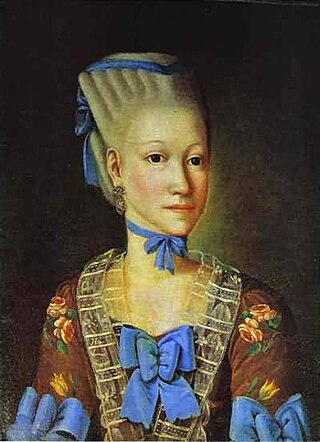
Grigory Silovich Ostrovsky (1756–1814) was a Russian portrait painter active during the 18th century in the Kostroma Governorate.

Mina Lukich Kolokolnikov was a Russian painter and teacher.

Aleksey Petrovich Antropov was a Russian painter active primarily in St. Petersburg, where he was born and died. He also worked in Moscow and frescoed churches in Kiev. His preferred medium was oil, but he also painted miniatures and icons.
Fyodor Gavrilov was a Russian painter active in the second half of the eighteenth century. The Tver Regional Picture Gallery contains a single painting by him, a portrait of Nikita Kuzhin which it accessioned in 1950; a label formerly affixed to the back of the painting dates it to 1767. Nothing further is recorded of his career.

Ivan Petrovich Argunov was a Russian painter, one of the founders of the Russian school of portrait painting.
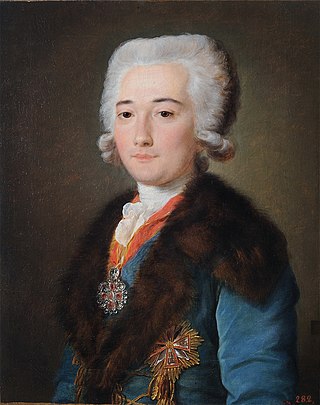
Mikhail Shibanov was a Russian painter active during the 1780s; a portrait of Count Alexander Dmitriev-Mamonov of which he is known to be the author dates to about this time. Shibanov was a serf of Prince Grigory Potemkin; his date of birth is unknown. Two of his genre scenes are held at the Tretyakov Gallery in Moscow; the above-mentioned portrait is in the Russian Museum now.

Pyotr Semyonovich Drozhdin was a Russian painter. He studied in St. Petersburg under Alexei Antropov and Dmitri Levitsky, and was granted the title of Academician in 1785.
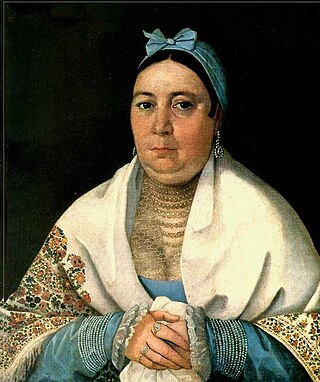
Nikolay Dmitrievich Mylnikov was a Russian portrait painter active during the nineteenth century in the Yaroslavl Governorate.

Pavel Kolendas was a Russian painter who lived and worked in Pereslavl-Zalessky.

The Communist Party of the Russian Soviet Federative Socialist Republic, was a communist political party in the Russian SFSR. The Communist Party of the Russian SFSR was founded in 1990. At this point, the Communist Party of the Russian SFSR being the republican branch of the Communist Party of the Soviet Union, organized around 58% of the total Communist Party membership. Politically, it became a centre for communist opponents of Gorbachev's leadership.

The Russian Soviet Federative Socialist Republic, previously known as the Russian Soviet Republic and the Russian Socialist Federative Soviet Republic, and unofficially as Soviet Russia, was an independent federal socialist state from 1917 to 1922, and afterwards the largest and most populous constituent republic of the Soviet Union (USSR) from 1922 to 1991, until becoming a sovereign part of the Soviet Union with priority of Russian laws over Union-level legislation in 1990 and 1991, the last two years of the existence of the USSR. The Russian SFSR was composed of sixteen smaller constituent units of autonomous republics, five autonomous oblasts, ten autonomous okrugs, six krais and forty oblasts. Russians formed the largest ethnic group. The capital of the Russian SFSR and the USSR as a whole was Moscow and the other major urban centers included Leningrad, Stalingrad, Novosibirsk, Sverdlovsk, Gorky and Kuybyshev. It was the first socialist state in the world.

Vasily Vasilievich Golubev was a Soviet, Russian painter. He lived and worked in Leningrad, was a member of the Leningrad Union of Artists, as is regarded as a representative of the Leningrad school of painting.

Savva (Savely) Vasilyevich Yamshchikov was a leading expert on Russian provincial art, particularly medieval icon painting and portrait painting of the 18th and 19th centuries.

Freemasonry in Russia started in the 18th century and has continued to the present day. Russian Freemasonry pursue humanistic and educational purposes, but more attention is given to ethical issues. It was a spiritual community of people united in an effort to contribute to the prosperity of the Motherland and the enlightenment of the people living in it.
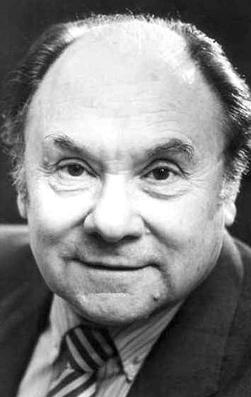
Nikolay Nikolaevich Trofimov was a Soviet and Russian theater and film actor. People's Artist of the USSR (1990).

At the Dressing-Table. Self-Portrait is a 1909 painting by Russian-French painter Zinaida Serebriakova. The painting is in the collection of the Tretyakov Gallery in Moscow. Its size is 75 × 65 cm.
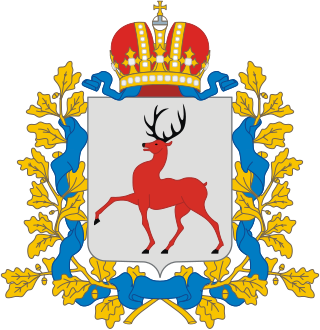
The Governor of Nizhny Novgorod Oblast is the head of Nizhny Novgorod Oblast.
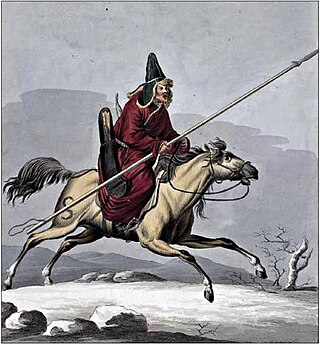
The malahai[a] is a historical headgear originating in present-day Kazakhstan, which was adopted in some of other regions of Central Asia and worn throughout the Russian Empire from the mid-18th to mid-19th centuries. It is a fur hat with a noticeably high conical, cylindrical, or quadrangular crown[c] and flaps that are typically four: two long side-flaps covering the ears, a wide rear one covering the neck and shoulders, and a short front one functioning as a visor. It is lined with furs of diverse animals, which include badger, fox, and wolf.

















